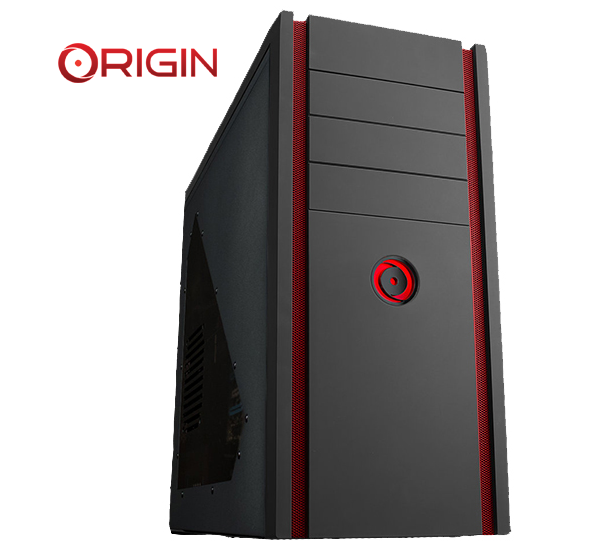Origin PC Millennium: 3-Way SLI And A 4.6 GHz Core i5
After a long hiatus, Tom's Hardware returns to consumer desktop reviews with Origin PC's Millennium. Can three GeForce GTX 660 Ti cards and an overclocked Core i5 handle gaming at 5760x1080? We want to know if this elegant box is worth its $3,000+ price.
Mid-Tower Might From Origin PC
If you’re looking to buy (or build) a performance-oriented gaming desktop, there are a few different directions you can take. The easiest route is to opt for today’s top-end parts and a gargantuan case big enough to house what you need now, plus whatever you might want to accommodate down the road.
Alternatively, if you don’t need multiple graphics cards and don’t plan on cramming additional components into your machine, you could go small and still keep things speedy with a microATX board, a powerful CPU, and a high-end graphics card. Several companies have headed down that route lately, including Alienware with its X51, Falcon Northwest and its granite-footed Tiki, and Digital Storm’s glossy Bolt.
Boutique system builder Origin PC offers something that’s a bit in-between those two extremes with its mid-tower Millennium system. Housed in a slightly tweaked BitFenix Shinobi case with red trim and a soft rubber-like finish, it’s smaller than a full-size tower at just 18.1" tall, but still roomy enough for a trio of powerful graphics cards.
Rather than going all out with two or three pricey Nvidia GeForce GTX 680 cards, Origin strapped a trio of GeForce GTX 660 Tis into the $3,073 test configuration it sent us. Complemented by an Intel Core i5-3570K CPU sporting an impressive 1.2 GHz overclock (to 4.6 GHz), and a pair of Intel SSD 520 drives in RAID 0, we already know from its specs that the Millennium is going to be an impressive performer. Enough so, we'd suspect, to drive a triple-monitor configuration with ease.
The downside to the three-way SLI setup is that upgrading isn’t going to be as easy as it would be with just one or two higher-end graphics cards. After all, you can’t just slap in another identical card a couple of years from now; this thing is completely maxed out already. The boot drive's RAID option also has a downside. While certainly speedy, a striped array is twice as likely to fail (if one drive goes out, your boot drive data is toast). Thankfully, Origin includes a roomy 1 TB hard drive as well, providing plenty of room for backup.
Get Tom's Hardware's best news and in-depth reviews, straight to your inbox.
Current page: Mid-Tower Might From Origin PC
Next Page Origin Millennium: Inside And OutAfter a rough start with the Mattel Aquarius as a child, Matt built his first PC in the late 1990s and ventured into mild PC modding in the early 2000s. He’s spent the last 15 years covering emerging technology for Smithsonian, Popular Science, and Consumer Reports, while testing components and PCs for Computer Shopper, PCMag and Digital Trends.
-
DarkSable So... no mention of the fact that you're paying for a lot of things you don't need? In it's head-to-head against the DIY rig, I'm noticing a LOT of parts that I wouldn't even consider spending extra money on.Reply
And they're getting those parts at a discount, so you're paying a lot of money for that tech line. -
EzioAs "This system’s starting price is a relatively modest $1,225. For that, you get a Core i3-2120 CPU, an AMD Radeon HD 7750 graphics card, and a 500 GB hard drive."Reply
Wow, talk about rip off... -
DarkSable Reply9539987 said:"This system’s starting price is a relatively modest $1,225. For that, you get a Core i3-2120 CPU, an AMD Radeon HD 7750 graphics card, and a 500 GB hard drive."
Wow, talk about rip off...
Haha, yeah. That's about what I spent for an i5-3570k and GTX 670. I'll stick with my hand-builts and NOT pay $700 for a tech support who reads from a script. -
mayankleoboy1 For this much price, i would add another $100 and get the i7-3770k. Those extra 4 cores will come in handy in apps.Reply
And probably get 2xHD7950. 2 card setups are easier to maintain than 3 card setups (drivers). And the compute capability of GCN is already legendry. -
Caspase mayankleoboy1For this much price, i would add another $100 and get the i7-3770k. Those extra 4 cores will come in handy in apps.And probably get 2xHD7950. 2 card setups are easier to maintain than 3 card setups (drivers). And the compute capability of GCN is already legendry.Reply
Those extra 4 threads. And I bet at stock it would lose.
Why aren't temperatures shown? I was curious to see how an ivy @ 4.6 in a mid tower with 3 GPUs with modest cooling would fair...

